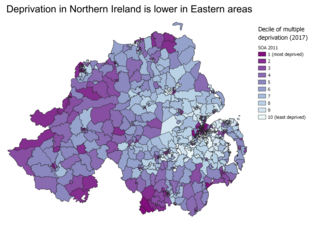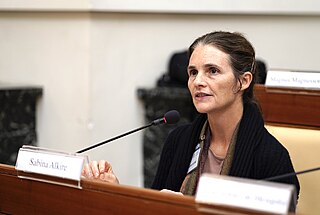
Extreme poverty is the most severe type of poverty, defined by the United Nations (UN) as "a condition characterized by severe deprivation of basic human needs, including food, safe drinking water, sanitation facilities, health, shelter, education and information. It depends not only on income but also on access to services". Historically, other definitions have been proposed within the United Nations.
Quality of life (QOL) is defined by the World Health Organization as "an individual's perception of their position in life in the context of the culture and value systems in which they live and in relation to their goals, expectations, standards and concerns".

Gross National Happiness, sometimes called Gross Domestic Happiness (GDH), is a philosophy that guides the government of Bhutan. It includes an index which is used to measure the collective happiness and well-being of a population. Gross National Happiness Index is instituted as the goal of the government of Bhutan in the Constitution of Bhutan, enacted on 18 July 2008.

The capability approach is a normative approach to human welfare that concentrates on the actual capability of persons to achieve lives they value rather than solely having a right or freedom to do so. It was conceived in the 1980s as an alternative approach to welfare economics.
The Human Poverty Index (HPI) was an indication of the poverty of community in a country, developed by the United Nations to complement the Human Development Index (HDI) and was first reported as part of the Human Development Report in 1997. It is developed by United Nations Development Program which also publishes indexes like HDI It was considered to better reflect the extent of deprivation in deprived countries compared to the HDI. In 2010, it was supplanted by the UN's Multidimensional Poverty Index.

The Human Development Report (HDR) is an annual Human Development Index report published by the Human Development Report Office of the United Nations Development Programme (UNDP).

Poverty in India remains a major challenge despite overall reductions in the last several decades as its economy grows. According to an International Monetary Fund paper, extreme poverty, defined by the World Bank as living on US$1.9 or less in purchasing power parity (PPP) terms, in India was as low as 0.8% in 2019, and the country managed to keep it at that level in 2020 despite the unprecedented COVID-19 outbreak. According to the World Bank, India experienced a significant decline in the prevalence of extreme poverty from 22.5% in 2011 to 10.2% in 2019. A working paper of the bank said rural poverty declined from 26.3% in 2011 to 11.6% in 2019. The decline in urban areas was from 14.2% to 6.3% in the same period. The poverty level in rural and urban areas went down by 14.7 and 7.9 percentage points, respectively. According to United Nations Development Programme administrator Achim Steiner, India lifted 271 million people out of extreme poverty in a 10-year time period from 2005–2006 to 2015–2016. A 2020 study from the World Economic Forum found "Some 220 million Indians sustained on an expenditure level of less than Rs 32 / day—the poverty line for rural India—by the last headcount of the poor in India in 2013."

In developing countries and some areas of more developed countries, energy poverty is lack of access to modern energy services in the home. In 2022, 759 million people lacked access to consistent electricity and 2.6 billion people used dangerous and inefficient cooking systems. Their well-being is negatively affected by very low consumption of energy, use of dirty or polluting fuels, and excessive time spent collecting fuel to meet basic needs.

Poverty is measured in different ways by different bodies, both governmental and nongovernmental. Measurements can be absolute, which references a single standard, or relative, which is dependent on context. Poverty is widely understood to be multidimensional, comprising social, natural and economic factors situated within wider socio-political processes.

A deprivation index or poverty index is a data set to measure relative deprivation of small areas. Such indices are used in spatial epidemiology to identify socio-economic confounding.

The Child Development Index (CDI) is an index combining performance measures specific to children—education, health and nutrition—to produce a score on a scale of 0 to 100. A zero score would be the best. The higher the score, the worse children are faring.
The Institute for International Economic Policy is a research institution dedicated to the study of global economic governance, based in Washington, DC at the Elliott School of International Affairs of the George Washington University. Notable IIEP members include Sabina Alkire, James Foster, and Jeni Klugman. Partnerships with organizations like the World Bank Group, International Monetary Fund, Internet Society, and The Nature Conservancy have led to academic conferences and policy seminars.

Multidimensional Poverty Indices uses a range of indicators to calculate a summary poverty figure for a given population, in which a larger figure indicates a higher level of poverty. This figure considers both the proportion of the population that is deemed poor and the 'breadth' of poverty experienced by these 'poor' households, following the Alkire & Foster 'counting method'. The method was developed following increased criticism of monetary and consumption-based poverty measures, seeking to capture the deprivations in non-monetary factors that contribute towards well-being. While there is a standard set of indicators, dimensions, cutoffs and thresholds used for a 'Global MPI', the method is flexible and there are many examples of poverty studies that modify it to best suit their environment. The methodology has been mainly, but not exclusively, applied to developing countries.
The OECD Better Life Index, created in May 2011 by the Organisation for Economic Co-operation and Development, is an initiative pioneering the development of economic indicators which better capture multiple dimensions of economic and social progress.

Sabina Alkire is an American academic and Anglican priest, who is the director of the Oxford Poverty and Human Development Initiative (OPHI), an economic research centre within the Oxford Department of International Development at the University of Oxford, England, which was established in 2007. She is a fellow of the Human Development and Capability Association. She has worked with organizations such as the Commission on the Measurement of Economic Performance and Social Progress, the United Nations Human Development Programme Human Development Report Office, the European Commission, and the UK's Department for International Development.
Gross National Well-being (GNW), also known as Gross National Wellness, is a socioeconomic development and measurement framework. The GNW Index consists of seven dimensions: economic, environmental, physical, mental, work, social, and political. Most wellness areas include both subjective results and objective data.
The Individual Deprivation Measure (IDM) is a new, gender-sensitive and multidimensional measure of poverty developed to assess deprivation at the individual level and overcome the limitations of current approaches which measure poverty at the household level.
The Fordham Francis Index is a multidimensional measure of international poverty. It is a simple tool that relies on seven primary indicators which are categorized into a Material Well-being Index and a Spiritual Well-being Index. It was launched on September 23, 2016 at a Fordham conference entitled Pope Francis' Call for Escaping Poverty co-sponsored by the Vatican Foundation Centesimus Annus Pro Pontifice. The research was conducted by students from Fordham's Graduate Program in International Political Economy and Development(IPED), under the research direction of Dr. Henry Schwalbenberg. The Fordham Francis Index is a response to the Pope's Address to the United Nations in New York last September 25, 2015.

James Eric Foster is Professor of Economics and International Affairs at the George Washington University, in the Elliott School of International Affairs, researching welfare economics and poverty measurement. He is known for developing the Alkire Foster Method, with University of Oxford professor and OPHI Director Sabina Alkire. He is a board member for the World Bank.
Kenya is a lower middle income economy, with Kenya's GDP hitting $150 billion as of 2024. This is due to increasing technology innovation services. Although Kenya's economy is the largest and most developed in eastern and Central Africa, 16.3% (2023/2024) of its population lives below the international poverty line. This severe poverty is caused by economic inequality, government corruption and health problems. In turn, poverty also worsens these factors. The Kenyan government's efforts to address poverty have received help from international institutions as well. The incident rate of poverty has steadily decreased, as shown by a recent MPI index.













